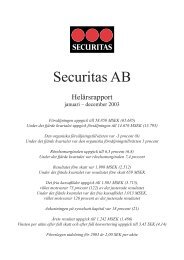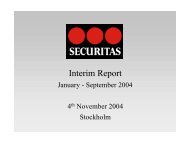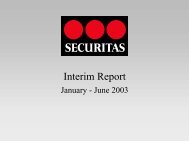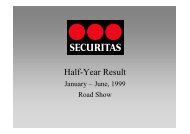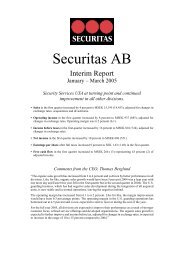Annual Report 2008 - Securitas
Annual Report 2008 - Securitas
Annual Report 2008 - Securitas
Create successful ePaper yourself
Turn your PDF publications into a flip-book with our unique Google optimized e-Paper software.
74<br />
<strong>Annual</strong> report<br />
Notes and comments to the consolidated financial statements<br />
Financial assets or financial liabilities at fair value through profit or loss<br />
Financial assets at fair value through profit or loss have two sub-categories:<br />
financial assets held for trading, and those designated at fair value through<br />
profit or loss at inception. A financial asset is classified in this category if<br />
acquired principally for the purpose of selling in the short-term or if so<br />
designated by management. Fair value derivative assets are also categorized<br />
as held for trading unless they qualify for hedge accounting. Assets in<br />
this category are classified as current assets if they are either held for trading<br />
or are expected to be realized within 12 months of the balance sheet date.<br />
Financial liabilities at fair value are trading securities with negative fair value;<br />
normally derivative liabilities unless they qualify for hedge accounting.<br />
Loans and receivables<br />
Loans and receivables are non-derivative financial assets with fixed or determinable<br />
payments that are not quoted in an active market. They arise<br />
when the Group provides money, goods or services directly to a debtor with<br />
no intention of trading the receivable. They are included in current assets,<br />
except for maturities later than 12 months after the balance sheet date.<br />
Held-to-maturity investments<br />
Held-to-maturity investments are non-derivative financial assets with fixed<br />
or determinable payments and fixed maturities that the Group’s management<br />
has the positive intention and ability to hold to maturity.<br />
Available-for-sale financial assets<br />
Available-for-sale financial assets are non-derivatives that are either designated<br />
in this category or not classified in any of the other categories. They<br />
are included in non-current assets unless management intends to dispose<br />
of the investment within 12 months of the balance sheet date.<br />
Financial liabilities designated as hedged item in a fair value hedge<br />
Financial liabilities designated for as hedged item in a fair value hedge are<br />
qualifying for hedge accounting. The hedging instrument is normally a derivative<br />
included in the category derivatives designated for hedging. Financial<br />
liabilities designated as hedged item in a fair value hedge are included in<br />
non-current liabilities except for maturities later than 12 months from the<br />
balance sheet date.<br />
Other financial liabilities<br />
Other financial liabilities are any financial liabilities that are not included<br />
under financial liabilities designated as hedged item in a fair value hedge.<br />
They are included in current liabilities except for maturities later than<br />
12 months from the balance sheet date.<br />
Derivatives designated for hedging<br />
Derivatives designated for hedging are instruments designated as hedging<br />
instruments and qualifying for hedge accounting. The Group normally only<br />
enters into derivative contracts when they either qualify for hedge accounting<br />
or when there is a natural off-set in the accounting.<br />
Most of the Group’s current assets are loans and receivables (including<br />
accounts receivable and most other current receivables). Financial assets<br />
or financial liabilities at fair value through profit or loss (with exception for<br />
derivatives), held-to-maturity investments and available-for-sale financial<br />
assets are normally categories in which the Group has no or very limited<br />
positions. Financial liabilities designated as the hedged item in a fair value<br />
hedge include both long-term and short-term loans designated as hedged<br />
items that are hedged effectively via derivatives designated for hedge<br />
accounting. Other financial liabilities comprise all other financial liabilities<br />
including such items as accounts payable and other current liabilities and<br />
also any long-term and short-term loans not included in financial liabilities<br />
designated for hedging. Further information is provided in the table Financial<br />
instruments by category – carrying and fair values in Note 6.<br />
<strong>Securitas</strong> <strong>Annual</strong> report <strong>2008</strong><br />
Recognition and subsequent measurement<br />
Purchases and sales of financial instruments are recognized on the trade date<br />
– the date on which the Group commits to purchase or sell the instrument.<br />
Financial assets and liabilities are initially recognized at fair value plus<br />
transaction costs for all financial assets or financial liabilities not carried at<br />
fair value through profit or loss. Financial assets or liabilities carried at fair<br />
value through profit or loss are recognized at fair value, and any transaction<br />
costs are charged to the profit or loss.<br />
Financial assets are derecognized when the rights to receive cash flows<br />
from the instruments have expired or have been transferred and the Group<br />
has transferred substantially all risks and rewards of ownership. Financial<br />
liabilities are removed when the obligation is discharged, cancelled or has<br />
expired.<br />
Financial assets or financial liabilities at fair value through profit or loss<br />
and available-for-sale financial assets are subsequently carried at fair value.<br />
Loans and receivables and held-to-maturity investments are carried at amortized<br />
cost using the effective interest method. Realized and unrealized<br />
gains and losses arising from changes in the fair value of the financial assets<br />
or liabilities at fair value through profit or loss category are included in the<br />
statement of income in the period in which they arise.<br />
Financial liabilities with the exception of financial liabilities at fair value<br />
through profit or loss and financial liabilities designated for hedging are subsequently<br />
carried at amortized cost.<br />
Financial liabilities designated as the hedged item in a fair value hedge<br />
are carried at amortised cost but are adjusted for changes in the fair value<br />
due to the hedged risk. changes in the fair value are included in the statement<br />
of income in the period in which they arise. The corresponding gain or<br />
loss from re-measuring the hedging instrument at fair value is also included<br />
in the statement of income in the same period as that in which the gain or<br />
loss on the hedged item arises.<br />
Cash flow hedging instruments are carried at fair value in the balance<br />
sheet and the gains or losses from re-measuring the hedging instruments<br />
at fair value are recognized in the hedging reserve in equity with a reversal<br />
from the hedging reserve to the statement of income in the period of which<br />
the cash flow of the hedged item impacts the statement of income. Exchange<br />
rate gains and losses on derivatives that are part of a net investment hedge<br />
relationship are recognized in equity.<br />
Actual cash flows (accruals) that arise from interest-rate derivative contracts<br />
are recognized as interest income and/or interest expense in the period<br />
to which they relate. changes in fair value (after accruals) for both the<br />
hedged item and the hedging instrument (derivative) are recognized separately<br />
as revaluation of financial instruments. The line revaluation of financial<br />
instruments is included within financial income and/or financial expense.<br />
The fair values of quoted financial instruments are based on current bid<br />
prices. If the market for a financial instrument is not active (and for unlisted<br />
securities), the Group establishes fair value by using valuation techniques.<br />
These include the use of recent arm’s length transactions, reference to other<br />
instruments that are substantially the same, discounted cash flow analysis,<br />
and option pricing models refined to reflect the issuer’s specific circumstances.<br />
Impairment of financial assets<br />
The Group assesses at each balance sheet date whether there is objective<br />
evidence that a financial asset or a group of financial assets is impaired.




